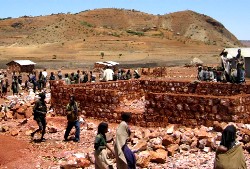You are here » Home » Telling Our Story
Success Story
Agricultural improvements improve Ethiopia's food security
Goats Bring Food and Development

| |
Photo: USAID/Kristina Stefanova
|
|
Farmers in a village near Sekota build a grain bank.
"If we have a problem now, we can just sell some of the goats," said Birhane
|
In 1984, a million people died of famine in the hot, dry region around Sekota, Ethiopia. Historically, crops barely grow in this isolated area of northern Ethiopia. There is little access to markets, which still leaves thousands hungry each year. Life expectancy is low, and treatable diseases kill many malnourished children.
Birhane Melese, a 40-year-old widow and Sekota resident, had struggled for years to feed her four children. But since she got her six goats, she has a steady supply of milk and butter and uses the manure to fertilize the potatoes, pumpkins, onions and chilies in her backyard. "If we have a problem now, we can just sell some of the goats," said Birhane.
She received her goats from USAID under a pilot project that is helping families develop their own means of income while increasing food security. Working closely with the Ethiopian government, USAID provides animals to the poorest Ethiopians and helps them learn about savings accounts, proper harvest storage and alternative work like beekeeping so that they can survive times of food shortage. A cornerstone of USAID's famine prevention strategy, the three-year, $400-million program aims to give 1.5 million people a productive safety net, in coordination with other government and partner efforts.
Two years into the program, Sekota's residents have constructed 71 miles (115 kilometers) of roads, making their district more accessible. In 2004, they planted thousands of fruit and tree seedlings and built two grain banks, where 291 farmers store sorghum, wheat, barley and beans to avoid post-harvest loss and conserve during lean periods. Six farmers' field schools were set up for villagers to learn about crop diversification and pest, soil and moisture management.
In the summer months, as food runs out, 47-year-old Sekota resident Wolde-Yohannes Allegue works on other people's farms or in road crews, often getting his pay in food and vegetable oil. He says he and his wife fight less over food now, and his seven children are eating a more varied diet.
Print-friendly version of this page (244kb - PDF)
Click here for high-res photo
Back to Top ^ | 

